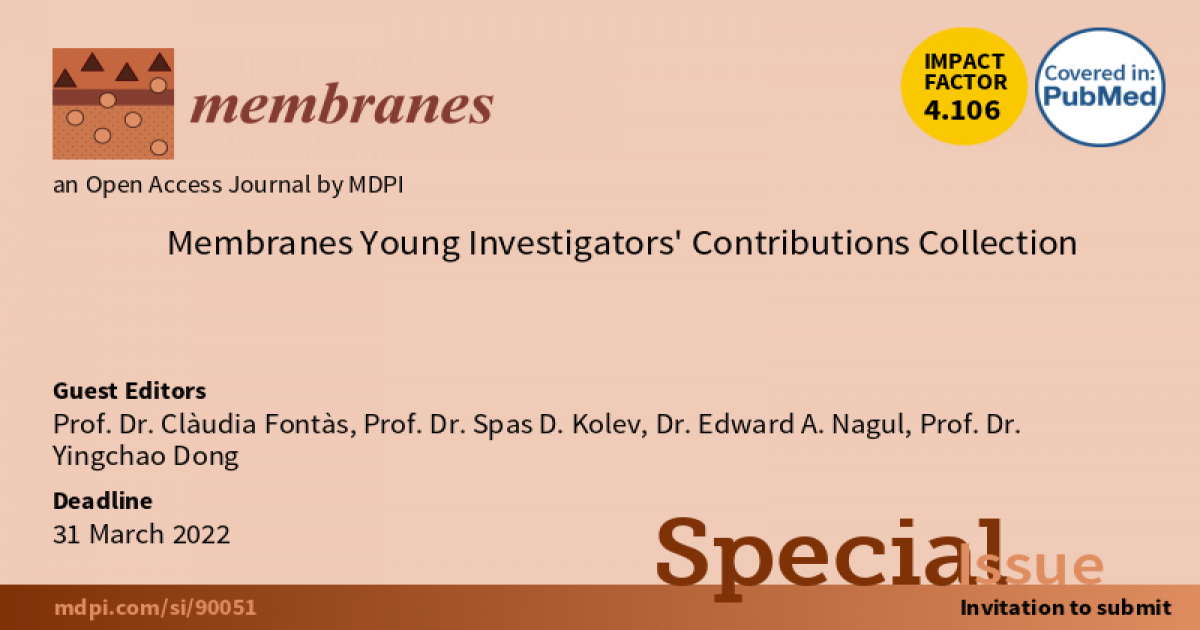Membranes Young Investigators' Contributions Collection
A special issue of Membranes (ISSN 2077-0375).
Deadline for manuscript submissions: closed (31 March 2022) | Viewed by 8037

Special Issue Editors
Interests: separation processes based on functionalized membranes; supported liquid membranes; polymer inclusion membranes; membrane systems for the clean-up of natural waters and industrial wastewaters; physico-chemical and electrical characterization of membranes; environmental and industrial sampling and analysis
Special Issues, Collections and Topics in MDPI journals
Interests: ion-exchange and liquid membranes; membrane applications in passive sampling; flow analysis; water treatment; chemical sensing; synthesis of metal nanoparticles
Special Issues, Collections and Topics in MDPI journals
Interests: polymer inclusion membranes; X-ray scattering; polymer characterisation; flow injection analysis
Special Issues, Collections and Topics in MDPI journals
Interests: inorganic membrane; water treatment; environmental material
Special Issues, Collections and Topics in MDPI journals
Special Issue Information
Dear Colleagues,
Membranes aims to compile the current trends and research directions of internationally renowned and successful young membrane scientists in one dedicated Special Issue. The idea for this Special Issue has arisen from the numerous and, above all, brilliant nominations for Membranes Young Investigator Award (https://www.mdpi.com/journal/membranes/awards).
In this Special Issue, we invite young investigators to submit manuscripts describing their ongoing research in this exciting field of membrane science. Young researchers are expected to lead the publications derived from their research, either as a first or corresponding author, regardless of whether they are in the early stages of their research careers (undergraduate, graduate, Master, and PhD students) or intermediate stage (postdoctoral researchers or junior group leaders), as long as they meet the requirement of being under 40 years old. Manuscripts covering original research as well as review articles, short communications, and perspective articles are acceptable for submission. With this new initiative, we wish to strengthen the networking of young researchers, paving the way to later stages of their research careers.
We are looking for your contributions!
Prof. Dr. Clàudia Fontàs
Prof. Dr. Spas D. Kolev
Dr. Edward A. Nagul
Prof. Dr. Yingchao Dong
Guest Editors
Manuscript Submission Information
Manuscripts should be submitted online at www.mdpi.com by registering and logging in to this website. Once you are registered, click here to go to the submission form. Manuscripts can be submitted until the deadline. All submissions that pass pre-check are peer-reviewed. Accepted papers will be published continuously in the journal (as soon as accepted) and will be listed together on the special issue website. Research articles, review articles as well as short communications are invited. For planned papers, a title and short abstract (about 100 words) can be sent to the Editorial Office for announcement on this website.
Submitted manuscripts should not have been published previously, nor be under consideration for publication elsewhere (except conference proceedings papers). All manuscripts are thoroughly refereed through a single-blind peer-review process. A guide for authors and other relevant information for submission of manuscripts is available on the Instructions for Authors page. Membranes is an international peer-reviewed open access monthly journal published by MDPI.
Please visit the Instructions for Authors page before submitting a manuscript. The Article Processing Charge (APC) for publication in this open access journal is 2700 CHF (Swiss Francs). Submitted papers should be well formatted and use good English. Authors may use MDPI's English editing service prior to publication or during author revisions.









